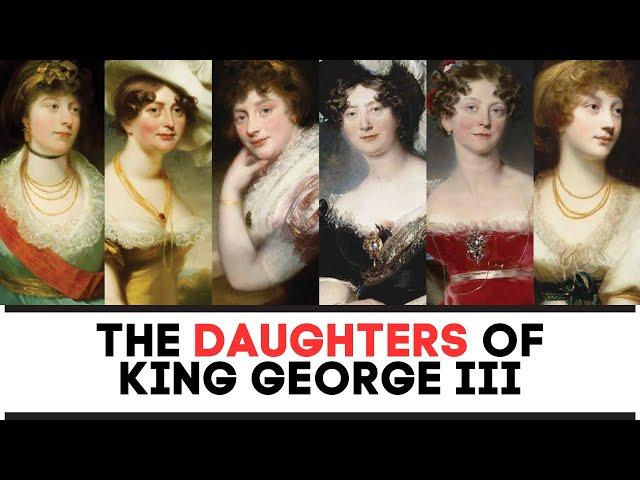
The DAUGHTERS Of King George iii | Full History Documentary
The DAUGHTERS Of King George iii | Full History Documentary
Charlotte, Princess Royal
The birth of a daughter was always a source of great joy for George III. His sons were boisterous and loud, but daughters represented the potential for a more tranquil family life. Throughout his life, the King showed a marked preference for his daughters over his sons. This preference was evident when his wife, Queen Charlotte, was in labor with their sixth child.
Princess Augusta Sophia
In total, George III and Queen Charlotte had fifteen children—nine sons, seven of whom survived to adulthood, and six daughters: Charlotte, Augusta, Elizabeth, Mary, Sophia, and Amelia. The King’s increasingly obsessive personality played a significant role in his relationships with his children, contributing to a highly controlled environment. This obsessive nature manifested in his micromanagement of even the smallest details of their lives.
Princess Elizabeth
The oppressive and controlled environment of their upbringing likely contributed to the princesses' development of certain traits, such as stammering and painful shyness. They described their mother’s household as a “nunnery,” a place of seclusion where they believed they would never escape. Their daily routines were monotonous and isolating, leading to deep frustration. Princess Sophia once bitterly wrote to her brother, the Prince of Wales, suggesting that she and her sisters might as well be "put in a sack and drowned in the Thames." Cultural expectations of noblewomen at the time meant that the princesses experienced these extremes of parental control far more than their brothers.
Princess Sophia
The topic of the princesses’ marriages was a sensitive one in the royal household. George III had once stated, “I cannot deny that I have never wished to see any of them marry: I am happy in their company, and do not in the least want a separation.” His mental illness, which first surfaced in 1765 and recurred throughout his reign, played a role in this sentiment. To keep her husband calm, Queen Charlotte discouraged any mention of marriage for their daughters. She herself was opposed to losing any of her daughters to marriage, especially as the King’s illness progressed and she became increasingly dependent on their company.
Princess Mary
Confined and isolated from society, the princesses formed romantic attachments within their immediate circle. Princess Augusta was rumored to have secretly married Sir Brent Spencer, though this was never publicly confirmed. Princess Sophia may have had a relationship with Major-General Thomas Garth, a member of the King’s household, and it is widely believed that she gave birth to a son as a result. This may explain why she never married, even after the Regency began and restrictions were lifted. Princess Amelia, the youngest, and often in poor health, had a relationship with the Honourable Charles Fitzroy.
Princess Amelia
Most of the princesses eventually married after the Regency was established and their parents’ control loosened. Desperate for independence, they accepted suitors quickly, even if they were not ideal matches. For example, Princess Elizabeth, upon meeting Prince Frederick of Hesse-Homburg in middle age, reportedly said, “If he is single, I will marry him.” Despite his lack of attractiveness and lower rank, this statement likely reflected her desire to escape her restrictive life.
Charlotte, Princess Royal
The birth of a daughter was always a source of great joy for George III. His sons were boisterous and loud, but daughters represented the potential for a more tranquil family life. Throughout his life, the King showed a marked preference for his daughters over his sons. This preference was evident when his wife, Queen Charlotte, was in labor with their sixth child.
Princess Augusta Sophia
In total, George III and Queen Charlotte had fifteen children—nine sons, seven of whom survived to adulthood, and six daughters: Charlotte, Augusta, Elizabeth, Mary, Sophia, and Amelia. The King’s increasingly obsessive personality played a significant role in his relationships with his children, contributing to a highly controlled environment. This obsessive nature manifested in his micromanagement of even the smallest details of their lives.
Princess Elizabeth
The oppressive and controlled environment of their upbringing likely contributed to the princesses' development of certain traits, such as stammering and painful shyness. They described their mother’s household as a “nunnery,” a place of seclusion where they believed they would never escape. Their daily routines were monotonous and isolating, leading to deep frustration. Princess Sophia once bitterly wrote to her brother, the Prince of Wales, suggesting that she and her sisters might as well be "put in a sack and drowned in the Thames." Cultural expectations of noblewomen at the time meant that the princesses experienced these extremes of parental control far more than their brothers.
Princess Sophia
The topic of the princesses’ marriages was a sensitive one in the royal household. George III had once stated, “I cannot deny that I have never wished to see any of them marry: I am happy in their company, and do not in the least want a separation.” His mental illness, which first surfaced in 1765 and recurred throughout his reign, played a role in this sentiment. To keep her husband calm, Queen Charlotte discouraged any mention of marriage for their daughters. She herself was opposed to losing any of her daughters to marriage, especially as the King’s illness progressed and she became increasingly dependent on their company.
Princess Mary
Confined and isolated from society, the princesses formed romantic attachments within their immediate circle. Princess Augusta was rumored to have secretly married Sir Brent Spencer, though this was never publicly confirmed. Princess Sophia may have had a relationship with Major-General Thomas Garth, a member of the King’s household, and it is widely believed that she gave birth to a son as a result. This may explain why she never married, even after the Regency began and restrictions were lifted. Princess Amelia, the youngest, and often in poor health, had a relationship with the Honourable Charles Fitzroy.
Princess Amelia
Most of the princesses eventually married after the Regency was established and their parents’ control loosened. Desperate for independence, they accepted suitors quickly, even if they were not ideal matches. For example, Princess Elizabeth, upon meeting Prince Frederick of Hesse-Homburg in middle age, reportedly said, “If he is single, I will marry him.” Despite his lack of attractiveness and lower rank, this statement likely reflected her desire to escape her restrictive life.
Тэги:
#George_III #British_monarchy #King_George_daughters #Princess_Charlotte #Princess_Augusta #Royal_family_history #Hanoverian_monarchy #Mad_King_George #Queen_Charlotte #British_royal_family #18th-century_history #Georgian_era #Princess_Elizabeth #Princess_Amelia #Royal_marriages #Regency_era #Royal_sisters #Mental_illness_history #Princess_Sophia #Royal_family_secrets #george_iii_children #queen_charlotte #queen_charlotte_daughters #queen_charlotte_bridgertonКомментарии:
Doctor Izard ️️ A Gripping Classic Mystery by Anna Katharine Green
Classic Detective Mysteries
Lexington Lodge No. 1
Jon Ruark
Wilmington North Carolina | What to know before moving to Wilmington NC
Living in Jacksonville NC


























